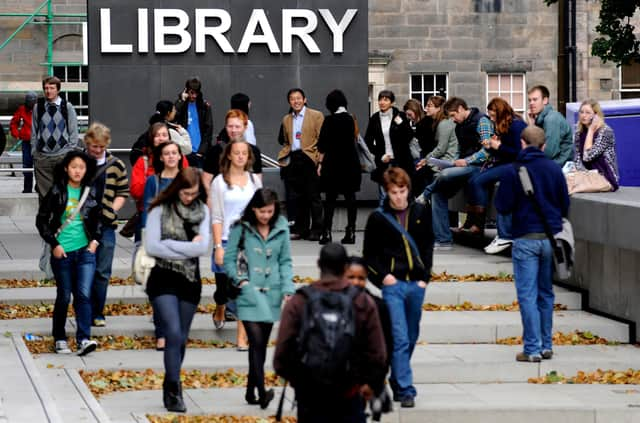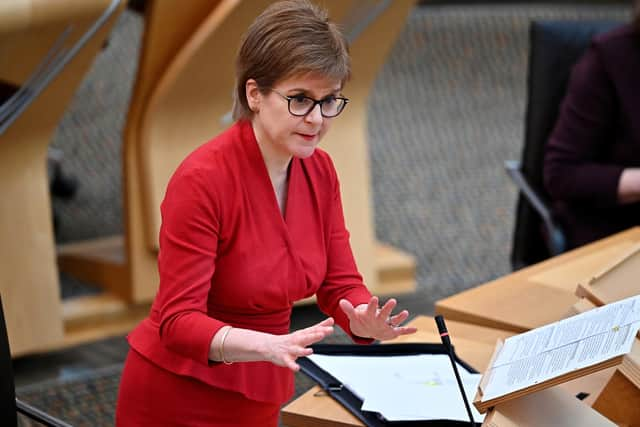Scottish exams 2021: Lowest proportion of Scotland's poorest students at university for five years


Figures published by UCAS on Tuesday show just 14.4 per cent of soon-to-be Scottish students will come from the poorest areas of Scotland – the lowest that figure has been since 2016.
This is in comparison to students from the least deprived areas of the country who make up more than a quarter (28.8 per cent) of all students.


Advertisement
Hide AdAdvertisement
Hide AdThe gap between the two figures is also at its widest since 2018 at 14.4 percentage points, meaning proportionately fewer of Scotland’s poorest teenagers receive a university place in 2021.
The statistics also raise questions as to whether this year’s exams system negatively impacted poorer students more after results showed the widening of the attainment gap when compared to 2020.
Opposition parties reacted with fury in response to the figures, with Scottish Labour stating the figures “lay bare” the SNP’s failure to tackle educational inequality.
The Scottish Conservatives also labelled them “damning” and “nothing short of a disgrace”.
While the overall number of students from the most deprived parts of Scotland continues to rise year-on-year, the proportion of students who hail from these areas is at its lowest level for five years.
In total, 14.43 per cent of all students in 2021 will be from the poorest areas of Scotland, a figure that has dropped year-on-year for the first time since 2014 and is at its lowest since 2016 when it sat at 13.36 per cent.
Since 2012, representation of the richest pupils in universities has declined. However, it rose for the first time since 2018 to 28.82 per cent this year, higher than the 2020 figure of 28.65 per cent, but lower than in 2019 when it was 29.05 per cent.
The number of pupils from Scotland’s most well-off areas getting a place at university has also risen at twice the rate as those from the most deprived parts of the country in 2021, the figures show.
Advertisement
Hide AdAdvertisement
Hide AdIt is the first time since 2016 that the number of Scotland’s poorest children going to university has risen at a slower rate than the number of those from the richest background.
Statistics released by UCAS show a year-on-year rise of 6.82 per cent in the number of university places going to those from the most deprived areas of Scotland.
However, places offered to those from the richest areas of Scotland have risen at twice that rate with a rise of 13.13 per cent when compared to 2020.
An analysis of the figures released by UCAS also shows of the 3,500 new places given to pupils on results day, almost a third (30 per cent) have gone to the richest in Scotland, with just 8.4 per cent being handed to the most deprived.
This is equal to a rise of 300 university places for those in the poorest parts of Scotland, compared with a rise of 1,090 in the least deprived areas.
More than half (55.2 per cent) of all of the new places have been taken by those considered to be within the 40 per cent of Scotland that is least deprived.
The figures are pre-clearing, meaning thousands more pupils will receive university places, but have been compared with equivalent results day figures from previous years.
They also exclude pupils who sat A levels or who are moving on to further education colleges.
Advertisement
Hide AdAdvertisement
Hide AdScottish Labour’s education spokesperson Michael Marra said the figures showed further evidence the “defining mission” of the SNP to reduce the attainment gap was being bungled.
He said: “These damning figures lay bare the SNP’s failure to tackle the scandal of educational inequality. Once more they have built inequality in to their assessment model, meaning the life chances of the poorest will be impacted the most.
“Education was supposed to be their defining mission, but the evidence is piling up that things are getting worse instead of better on far too many counts.
“This is the result of a complete lack of leadership from the government, both during the pandemic and over the last 14 years.
“At every stage of their education, it is young people from the most deprived backgrounds paying the price for the SNP’s incompetence on education. We have a moral imperative to act now to close the attainment gap and remove the barriers preventing the poorest pupils from going to university.”
Reacting to the statistics, the Scottish Conservatives higher and further education spokesperson Pam Gosal repeated calls for an apology to Scottish pupils.
She said: “The SNP have failed miserably to close the attainment gap. Ministers have described it as their defining mission, but these statistics are absolutely damning.
“Even prior to the pandemic, the SNP had not done enough to tackle the widening gap between pupils from rich and poor backgrounds in our schools.
Advertisement
Hide AdAdvertisement
Hide Ad“They had limited subject choice for pupils, slashed teachers from our classrooms and failed to focus on addressing long-standing inequalities.
“Yet again, under the SNP, it appears that pupils opportunities are dependent on where they grow up. That is nothing short of a disgrace.
“SNP ministers must apologise immediately and urgently outline how they will guarantee pupils future education prospects won’t be determined by their background.”
Beatrice Wishart, the education spokesperson for the Scottish Liberal Democrats, said: "There can now be no doubt that the pandemic has hit pupils in the poorest areas much harder than their wealthier counterparts.
"The Scottish Government and their education quangos are responsible for a scandal that will see bright pupils from tougher backgrounds thwarted in their desire to go to university.
"The government now needs to ensure that there is now a place in further or higher education, training or a job available for all of those leaving school this year."
Several thousand appeals are also with the SQA, the quango’s chief executive said on Tuesday, with a further 300 individuals taking advantage of the incomplete evidence service, allowing them to submit their estimated grades later than others.
Reacting to the overall figures for university places, with 31,070 Scottish domiciled pupils to head to Scottish universities, National Union of Students president Matt Crilly said the attainment gap was “disheartening”.
Advertisement
Hide AdAdvertisement
Hide AdHe said: “The pandemic has highlighted the class inequalities in Scottish education and society – it’s time to rebuild our systems to be fairer for everyone.
“No students’ grades should be dependent on their background. Lessons must be learned by the Scottish Government recognising the hard work of students and the need for continued support in coming years.”
A Scottish Government spokesperson said: “Today’s university places statistics figures confirm that university acceptances from SIMD20 areas to UK universities are at a record high, and the poverty-related attainment gap in SQA results is narrower than in 2019 – all achieved by Scotland’s young people in one of the toughest academic years we’ve ever known.
“The UCAS statistics on SIMD proportions have seen a cohort change this year due to the joint release dates of SQA and JCQ data and are therefore not completely comparable with previous years.
"As more offers are processed in the coming days, and clearing places are secured, a more accurate picture of SIMD proportions will become available.”
A message from the Editor:
Thank you for reading this article. We're more reliant on your support than ever as the shift in consumer habits brought about by coronavirus impacts our advertisers.
If you haven't already, please consider supporting our trusted, fact-checked journalism by taking out a digital subscription.
Comments
Want to join the conversation? Please or to comment on this article.

